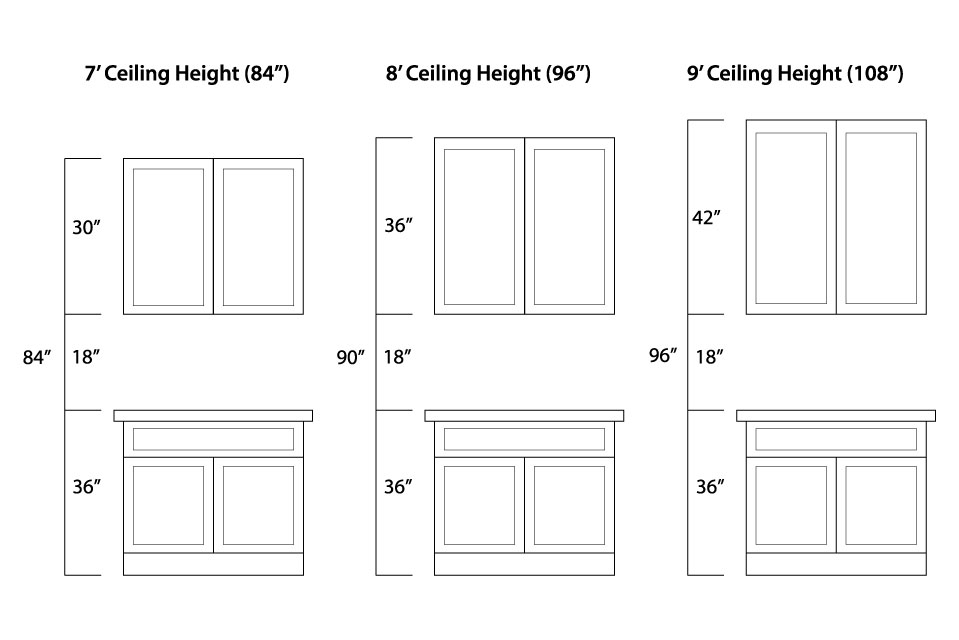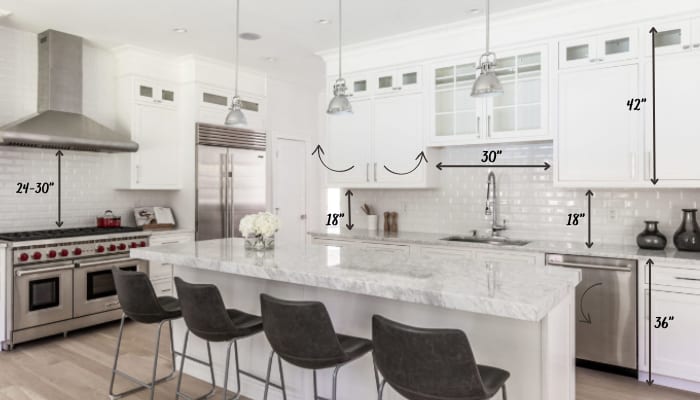Ideal Distance for Functionality

The distance between your countertops and wall cabinets plays a crucial role in the overall functionality and usability of your kitchen. A well-designed space considers the comfort and efficiency of the user, making cooking and food preparation a more enjoyable experience.
Optimal Distance for Comfort and Efficiency
The ideal distance between countertops and wall cabinets is generally considered to be between 18 and 24 inches. This range allows for sufficient clearance for bending, reaching, and working comfortably without bumping your head or straining your back.
Countertop and Cabinet Heights and Their Impact on Usability
The height of both your countertops and wall cabinets significantly influences the optimal distance. Here are some common combinations and their implications:
- Standard Countertop Height (36 inches) and Standard Wall Cabinet Height (30 inches): This combination results in a 6-inch distance, which might be too small for taller individuals or those who frequently work with large pots and pans.
- Standard Countertop Height (36 inches) and Taller Wall Cabinet Height (36 inches): This combination provides a 12-inch distance, offering more headroom and clearance for movement. It is generally considered a comfortable and functional option for most individuals.
- Raised Countertop Height (42 inches) and Standard Wall Cabinet Height (30 inches): This combination creates a 12-inch distance, providing ample space for tall individuals or those who prefer a more ergonomic workspace.
Adjusting the Distance Based on User Height and Kitchen Purpose
The ideal distance can be adjusted based on the user’s height and the specific needs of the kitchen. For example:
- Tall Individuals: A larger distance, potentially exceeding 24 inches, might be necessary for comfortable movement and reaching.
- Short Individuals: A smaller distance, potentially closer to 18 inches, could be more comfortable and efficient.
- Kitchens Designed for Frequent Baking: A larger distance could be beneficial for accommodating tall mixing bowls and other baking equipment.
- Kitchens with Limited Space: A smaller distance might be necessary to maximize storage space and minimize the overall footprint of the kitchen.
Factors Influencing Distance

The ideal distance between your countertop and wall cabinets isn’t a one-size-fits-all situation. Several factors come into play, and understanding these factors will help you create a kitchen that’s both functional and aesthetically pleasing.
Appliances and Fixtures, Distance between countertop and wall cabinets
The placement of appliances and fixtures significantly impacts the required clearance. For instance, a microwave mounted above the stove requires a greater distance than a standard cabinet.
- Microwave above stove: Allow 18-24 inches for comfortable access and to prevent heat damage to the cabinets.
- Range hood: Depending on the size and design of the range hood, you may need 18-30 inches of clearance.
- Faucets: A tall gooseneck faucet might require more clearance than a standard faucet.
Cabinet Design
The design of your cabinets, including door styles, hinges, and drawer pulls, influences the necessary clearance.
- Door styles: Cabinets with doors that open outwards require more space than cabinets with doors that open upwards or sideways.
- Hinges: Hinges that extend beyond the cabinet face can require additional clearance. For example, European-style hinges often require less space than traditional hinges.
- Drawer pulls: Oversized or protruding drawer pulls can impact the required distance. Consider choosing drawer pulls that are flush with the cabinet face or have a small profile.
Countertop Material
The type of countertop material can also impact the ideal distance. Some countertop materials, like granite or quartz, are naturally strong and can support a greater overhang than other materials like laminate.
- Overhang: Countertops that extend beyond the base cabinets (overhang) can affect the required distance. The amount of overhang is determined by the material’s strength and the weight it needs to support.
- Material strength: Stronger countertop materials like granite or quartz can handle a greater overhang than weaker materials like laminate. This is because they are less prone to bending or cracking under stress.
Design Considerations and Safety: Distance Between Countertop And Wall Cabinets

Beyond functionality, the distance between countertops and wall cabinets is crucial for aesthetic appeal and safety. This distance directly impacts the overall flow and usability of your kitchen.
Countertop and Cabinet Combinations with Recommended Distances
The recommended distance between countertops and wall cabinets varies depending on the type of countertop and cabinet design. Here’s a table showcasing common combinations and their ideal distances:
| Countertop Type | Cabinet Style | Recommended Distance (inches) |
|---|---|---|
| Standard Laminate | Standard Base Cabinet | 18-21 |
| Granite or Quartz | Raised Panel Cabinet | 19-22 |
| Butcher Block | Shaker Style Cabinet | 20-23 |
Safety Hazards Associated with Inadequate Clearance
Insufficient clearance between countertops and wall cabinets poses various safety risks. These include:
- Head Injuries: A low cabinet can lead to head bumps and injuries, especially for taller individuals or those who frequently move around the kitchen.
- Access Limitations: Inadequate clearance can hinder access to cabinets, making it difficult to reach items stored at the back. This can lead to frustration and potential injuries while trying to retrieve items.
- Increased Risk of Accidents: With limited space, it’s easier to bump into cabinets, increasing the risk of spills, broken dishes, and other accidents.
Maximizing Storage Space While Maintaining Safe Distances
While maintaining sufficient clearance is crucial, there are ways to maximize storage space without compromising safety:
- Utilize Vertical Space: Install tall cabinets with shelves or drawers that reach up to the ceiling, maximizing storage space without compromising headroom.
- Implement Pull-Out Shelves: Consider pull-out shelves or drawers for easy access to items stored at the back of cabinets, eliminating the need to reach far into the cabinet.
- Utilize Corner Cabinets: Optimize corner space with revolving corner cabinets or pull-out shelves, allowing for efficient storage and access.
- Install Open Shelving: Instead of traditional cabinets, consider open shelving for a more airy and modern look, providing easy access to frequently used items while maximizing storage space.
Distance between countertop and wall cabinets – The optimal distance between a countertop and wall cabinets is crucial for both functionality and aesthetics. A comfortable reach for accessing items stored in the cabinets is essential, but so is visual harmony. This balance can be achieved by incorporating design elements that complement the overall space, such as a bold and romantic color scheme, like the ones featured in pink and red bedroom ideas.
Similarly, a well-planned countertop-to-cabinet distance enhances the flow of the kitchen, making it a more enjoyable and efficient space to work in.
The ideal distance between a countertop and wall cabinets is typically 18-24 inches, allowing for comfortable movement and access to both surfaces. However, when designing a bedroom, comfort and safety are paramount. Consider incorporating padded wall panels for bedroom to prevent bumps and bruises, especially in areas with low lighting.
These panels can also add a touch of style and warmth to the room, creating a more inviting atmosphere. Just as the countertop-cabinet distance is crucial for functionality, the choice of wall coverings directly impacts the user experience in a bedroom.